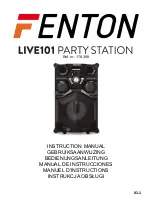
Operating manual HVL 120-0.3
7 MAINTENANCE / SERVICING
The low voltage limiter HVL 120-0.3 contains no parts that are subject to wear, and therefore is
maintenance-free. Spare parts are not required.
We recommend that the following work is carried out at regular intervals (at the latest, however, every 5
years) on all low voltage limiters that are in service.
Before beginning the work, check the safety distance to adjacent live parts or
equipment. If there is a danger of inadvertent touching, the 5 safety rules for
establishing and securing the de-energised condition at the work location must be
carried out (see the section entitled Safety instructions).
Secure yourself against falling if the intended mounting position is on a mast or on a
high-level structure. For this purpose, use a secure working platform and wear your
personal protective equipment.
o
Inspect the low voltage limiter for any kind of damage such as, for example, the effects of electrical
arcing or defects in the housing. Damaged low voltage limiters must be replaced by new ones.
o
Inspect all screwed connections.
o
In the event of exceptional contamination, the low voltage limiter should be cleaned. For this, we
recommend that a soft cloth is used with warm water and a mild household cleaner (do not use
solvents or abrasive cleaning agents).
Faults and reserve equipment
The low voltage limiter is a protective equipment element and therefore overloading can never be completely
excluded. Depending on the number of units in operation, it is recommended that a suitable number of spare
units is kept in reserve.
Note on behaviour in fire
The silicon housing of the low voltage limiter is self-extinguishing (Oxigene Index LOI equates to 26.9% in
accordance with ISO 4589/84).
Effects of animal damage
Slight mechanical damage to the silicon grouting (for example, from the bites of animals such as birds and
martens) does not impair the function of the low voltage limiter.
Function checks by means of resistance measuring
A complete function check of the low voltage limiter is not possible at the installed location. Overloading of
the low voltage limiter can lead to a breakdown (short circuiting) of one or both thyristors. If there are any
doubts about the function of the low voltage limiter, we recommend that a resistance measurement is carried
out with a standard Multimeter. Before carrying out this measurement, the low voltage limiter must be
removed from the electrical circuit.
1HC0023892 AA
EN
Page 9 / 12






























